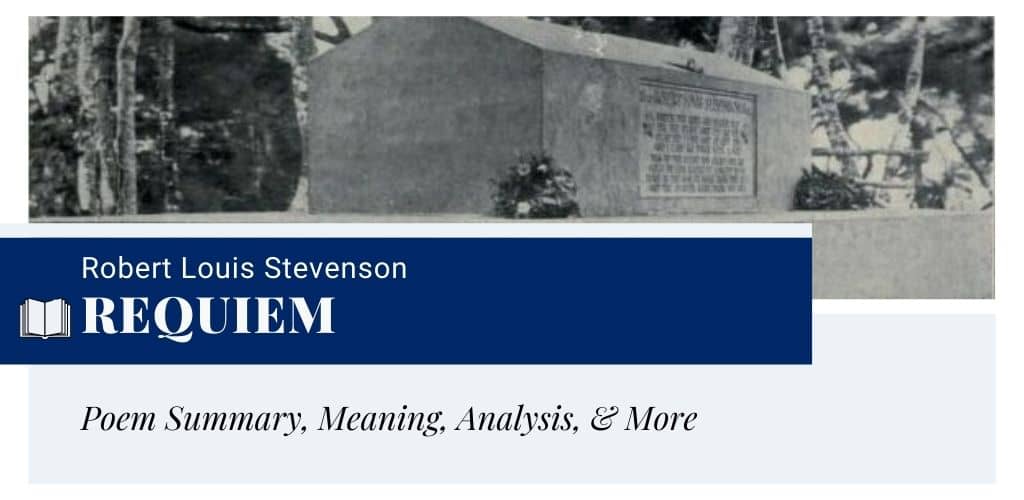Requiem by Robert Louis Stevenson
“Requiem” is engraved, as directed by Robert Louis Stevenson, on his grave. Stevenson died suddenly on 3 December 1894 when he was talking with his wife. He collapsed after uttering two words “What’s that?” Within a few hours, he vanished into non-entity at the age of 44. Before his death, he wished the lines of this poem to be engraved on his tombstone. The most iconic lines of this piece include:
Here he lies where he longed to be;
Home is the sailor, home from sea,
And the hunter home from the hill.
- Read the full text of “Requiem” below:
Requiem
by Robert Louis Stevenson
Under the wide and starry sky,
Dig the grave and let me lie.
Glad did I live and gladly die,
And I laid me down with a will.
This be the verse you grave for me:
Here he lies where he longed to be;
Home is the sailor, home from sea,
And the hunter home from the hill.

Summary
The poem “Requiem” is about a wish of the poet R.L. Stevenson concerning where he should be laid after his death. He describes the wide sky, lit with several stars. His wish is to lie beneath such a glorious sky. He has lived gladly. So he wants to gladly embrace death. It is not that death will be victorious over him. He laid himself down with a will, a determination of death. After his death, he wants a few lines to be sung commemorating him. These lines feature a “home” that is compared to a “sailor” and “hunter”. While death is represented as “sea” and “hill”.
Meaning
The title of the poem “Requiem” means an act or token of remembrance. This poem is a remembrancer of the poet that he left behind for his dear readers. Besides, the term also means a mass for the repose of the souls of the dead. So, Stevenson wrote this piece for two purposes. One is to make him memorable in the minds of his readers as a “sailor” or a “hunter” (in their metaphorical sense). Another reason concerns how he wants to be remembered. He does not want to die like a person defeated by death. Rather his wish is to be reminded of as a person who accepted death wholeheartedly.
Form, Rhyme Scheme, & Meter
This poem consists of two stanzas. Each stanza has four rhyming lines. The rhyme scheme of the overall piece is AAAB CCCB. It means the first and last line rhymes together. In the first quatrain, the first three lines end with a similar rhyme (“sky”, “lie”, and “die”). The same applies to the first three lines of the second quatrain. Regarding the meter, each line consists of eight syllables except the second line, which consists of seven syllables. In most cases, the stress falls on the second syllable of each foot. Thus, the poem is composed in iambic tetrameter with a few variations. Let’s have a look at the metrical scheme of the first stanza:
Un-der/ the wide/ and star/-ry sky,
Dig/ the grave/ and let/ me lie.
Glad/ did I live/ and glad/-ly die,
And I laid/ me down/ with a will.
Literary Devices & Figurative Language
Stevenson uses the following literary devices in his poem “Requiem”:
- Alliteration: The repetition of similar sounds in neighboring words can be found in “starry sky”, “dig the”, “let me lie”, “Here he”, and “hunter home”.
- Inversion: It occurs in “Glad did I live and gladly die”. Here, the regular sentence pattern is reversed.
- Metaphor: In the last two lines, Stevenson metaphorically compares death to a “sea” and a “hill”. While he compares himself to a “sailor” and a “hunter”. As a sailor longs for the sea, so does the poet.
- Repetition: There is a repetition of the word “glad” in the third line. In the last two lines, he repeats the word “home” thrice. It is meant for the sake of emphasis.
Line-by-Line Analysis & Explanation
Lines 1-4
Under the wide and starry sky,
Dig the grave and let me lie.
Glad did I live and gladly die,
And I laid me down with a will.
Stevenson’s “Requiem” begins with visual imagery. The poet depicts a beautiful wide sky, lit with stars. Such a sky is a symbolic representation of glory. In the following line, the poet orders his grave to be dug under such a sky. His tone is peaceful and welcoming. He does not fear death. Rather he says, “let me lie”.
According to him, he lived happily. So, why can he be sad at his death? As he lived, he wants to die peacefully, with a smile on his face. If anyone thinks that he is mentally defeated by death. It is not the case.
In the following line, he remarks that he laid his body down. He does it with a will, a determination engendering directly from his heart. His soul cannot be defeated. Even if he dies, he will live through the variety of works he created during his lifetime. This poetic “will” displays his unrelenting attitude.
Lines 5-8
This be the verse you grave for me:
Here he lies where he longed to be;
Home is the sailor, home from sea,
And the hunter home from the hill.
In the final quatrain, the poet writes the verse that should be graved as his epitaph. Besides, the term “grave” means to fix indelibly in the mind. So, the lines he writes should be engraved in his readers’ minds. When they think about the poet, they should visualize him in the way he wants.
He points at this grave and tells readers that it is the place he longed to lie in. He does not fear death or the cold grave. In the following lines, he gives the reason for thinking so.
According to him, “home is the sailor”. Here, he compares himself to a sailor. This body is his second home and the “sea” symbolizes his permanent place. Like a sailor cannot live without voyaging on the sea, the poet longs for the metaphorical “sea” death.
In the following lines, he uses another analogy of a “hunter” and “himself”. A hunter is never happy staying at home. He becomes restless for hunting. When he goes to the hill, he becomes happy and fulfilled. Likewise, the poet is going to be happy when he leaves his mortal home and goes up the “hill”. This “hill” is a symbolic reference to heaven or eternal life. Only death can help him to reach there. Hence, he accepts death with all his heart.
Historical Background
The first draft of “Requiem” was composed in 1880. In 1879, Stevenson was near death when he arrived in Monterey, California. By December, he had recovered his health and traveled to San Francisco, California. But by the end of the winter, he was so ill that he found himself at death’s door. This experience made him write this poem. He mentioned his tombstone and epitaph in a letter of February 1880. Stevenson always wanted his poem “Requiem” inscribed in his tomb. After his death, on 3 December 1894, he was buried at Mount Vaea. The lines were inscribed on his tombstone thereafter.
Questions & Answers
In 1879, Stevenson went to California to marry Fanny Osbourne. His health was broken there and he found himself extremely close to death. It led him to think about his death and he wrote the poem “Requiem” as an epitaph for his grave. He wanted these lines to be inscribed on his tomb.
The poem “Requiem” is about the poet’s final wish. Through this poem, he describes how he wants to be remembered after his death. He also specifies the location where he wants to be buried.
Stevenson wrote this poem in 1880 when he was in California.
Stevenson was buried at Mount Vaea, located in Samoa. He lived the last four years of his life on the east side of Mount Vaea and chose the mountain top as his final resting place.
It is a lyric poem written in a regular rhyme scheme. The first-person speaker (Stevenson) talks about his final wish in this poem.
Explore More R. L. Stevenson Poems
External Resources
- About “Requiem” — Rad more about the poem and explore a short sketch on the poet’s life.
- Dating of “Requiem” — Learn about the date of composition and the historical background of the poem.
- About Robert Louis Stevenson — Read about the poet’s life and his works.
- Poet Profile & Poems of R. L. Stevenson — Learn more about the poet and explore more of his poems.






The rhyming scheme is AAAB CCCB not as described here.
The scansion offered is inaccurate: “and i LAID me DOWN with a WILL”
The fourth line of each stanza is a trimester, not a tetrameter. More joyous, more final, more dramatic. Just read it out loud in a natural voice and it will be clear.
..HUNT . HOME.. HILL ..LAID . DOWN .. WILL
Don’t try to force it into iambics when the dancing anapaests and dactyls enhance the pleasure of these verses. The underlying rhythm of iambic tetrameters is not adhered to anywhere in the poem. Every line is a variant form. Even the second line is seven syllables long. A regular iambic would need an extra syllable at the start of the line:
(you’ll) DIG the GRAVE and LET me LIE
GLAD did i LIVE and GLADly DIE /
THIS VERSE GRAVE ME
UN WIDE STAR SKY
Thanks, Robert for your thoughtful input. We’ve amended the mistakes.
My pleasure. Glad to be of help.
I should have thought that the sea and the hill do not represent heaven but that home does. The sailor longs to make land and the hunter to return to his home. In either case the weary sojourner is glad to return to his home and rest from his travails.